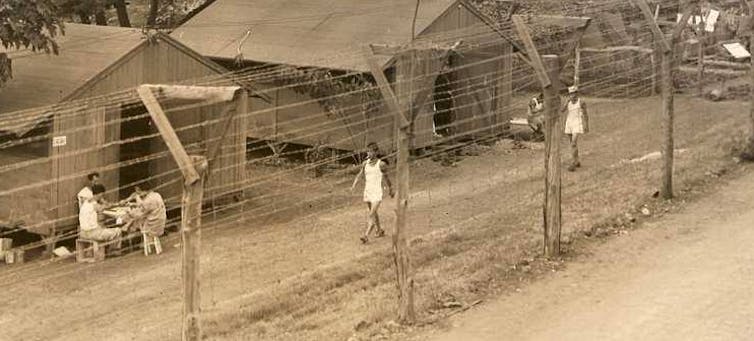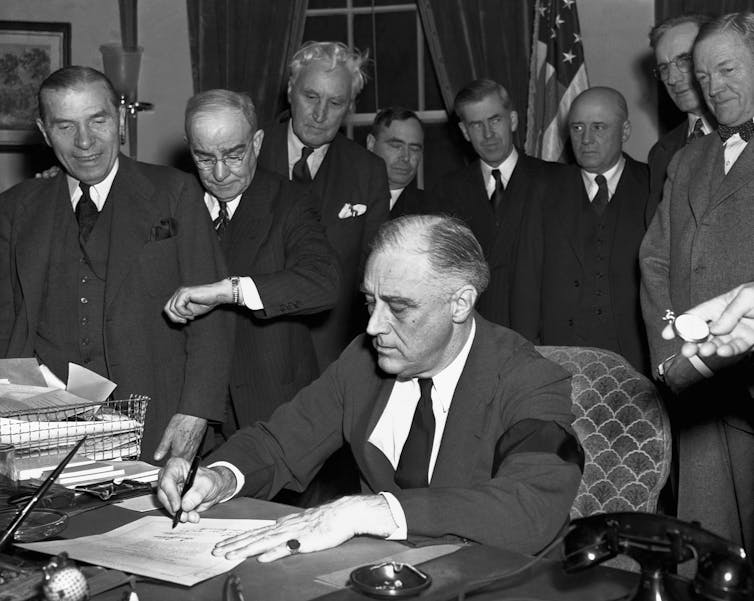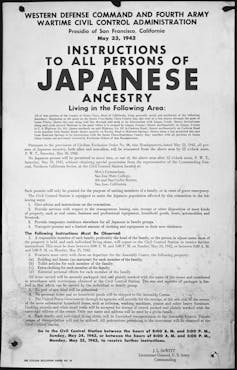The Forgotten History of Japanese Internment in Hawaii

A 1945 photograph of detainees at the Honouliuli Internment Camp. courtesy of National Park Service
Olivia Tasevski, The University of Melbourne
In the months and years following Japan’s bombing of Pearl Harbor in Hawaii on Dec. 7, 1941, the U.S. government incarcerated a large number of Japanese American civilians from the U.S. mainland.
Often forgotten are the Japanese Americans who lived in Hawaii and were also forced from their homes and imprisoned in Hawaii and on the U.S. mainland.
Their forced relocation and incarceration has been largely omitted from the dominant narrative of Japanese American internment in the U.S. during World War II. Additionally, attempts by governments to provide redress to those individuals and memorialize their treatment have been slower than for individuals interned on the U.S. mainland.
Internment in the US mainland and Hawaii
In February 1942, President Franklin Roosevelt issued Executive Order 9066, which allowed for the creation of U.S. military areas from which people could be excluded.
Although the executive order made no mention of any ethnic group, it implicitly targeted Japanese Americans because of widespread xenophobic fear that they would spy for the Japanese government or engage in acts of sabotage within the U.S.

On Dec. 8, 1941, a day after the attack on Pearl Harbor, President Franklin D. Roosevelt signed the U.S. declaration of war against Japan. Bettmann/GettyImages
As a result, almost 120,000 civilians of Japanese ancestry, the majority of whom were from the West Coast and were American citizens, were incarcerated in camps by the government on suspicion that they posed a threat to U.S. security on basis of their ancestry.
In Hawaii, which had been colonized by the U.S. in 1898, the incarceration of Japanese Americans was much smaller in scale than that on the mainland.
Given that Japanese Americans made up more than one third of Hawaii’s total population during World War II and thus a sizable wartime labor force, U.S. forces incarcerated about 2,000 Japanese Americans from Hawaii. These people included community figures, Japanese language teachers and Shinto priests.
Additionally, hundreds of Japanese Americans in Hawaii, although not imprisoned, were forcibly removed from their homes, taken to other parts of the territory and, at times, not permitted to return to their homes.

With the authorization of the U.S. government, the U.S. military rounded up and incarcerat Japanese Americans shortly after Japan’s attack on Pearl Harbor. History/Universal Images Group via Getty Images
The Honouliuli Internment Camp, known as Hell Valley among internees, opened in 1943 on the island of Oahu and was the largest confinement site in Hawaii.
Unlike other camps in Hawaii, it housed civilians and prisoners of war. During its three years of operation, the camp held around 320 Japanese American civilians.
The camps in Hawaii, as on the mainland, were crowded, monitored by armed guards and surrounded by barbed wire fences.
As a result of their detention, former prisoners have experienced mental health issues alongside heightened rates of suicide and early death.
Official US redress
Following years of advocacy by Japanese American organizations, President Jimmy Carter authorized the creation of the Commission on Wartime Relocation and Internment of Civilians in 1980.
Three years later, the commission issued recommendations, including that the U.S. government apologize and provide reparations of US$20,000 to Japanese American survivors, including Japanese Americans from Hawaii.
Despite his initial opposition to the commission’s recommendation that the U.S. government provide reparations, in 1988, President Ronald Reagan signed the Civil Liberties Act, which provided a formal apology and reparations of $20,000 to many former internees.
At the signing, Reagan referred to Japanese American internment as a “grave wrong” that was undertaken “without trial … based solely on race.”
Despite this, he made no reference to the fact that the civilian camps were created and run by the U.S. government and Army, nor did he recognize that these actions constituted human rights abuses.
Furthermore, upon its creation, the Civil Liberties Act had a significant flaw – it excluded hundreds of affected Japanese Americans from Hawaii from receiving that restitution.
That oversight was corrected in 1992, when President George H.W. Bush signed into law the Civil Liberties Act Amendments, which broadened eligibility for restitution.
Selective memorialization
Since that period, U.S. government and nongovernment organizations have selectively memorialized Japanese American incarceration by designating some prison camps as national historical sites and creating mainland-centric memorials.
For example, the National Japanese American Memorial to Patriotism During World War II in Washington, D.C., created in 2000, includes multiple walls inscribed with the names of all mainland internment camps and the number of individuals interned there, but makes no reference to specific prison camps in Hawaii.
That said, the monument, which was organized by a Japanese American NGO, does include an inscription which recognizes that Japanese Americans were incarcerated in the mainland and Hawaii.
Additionally, between 1992 and 2008, mainland camps Manzanar and Tule Lake in California and Minidoka in Idaho were designated as national historical sites or monuments by U.S. presidents or Congress. However, it was not until 2015 that President Barack Obama designated the Honouliuli Internment Camp a national monument.
This selective memorialization is unsurprising given that Hawaii, like other territories colonized by the U.S., is often omitted from accounts of American history. Nonetheless, such memorialization is problematic, as it reinforces the dominant narrative of Japanese American incarceration that focuses on the mainland camps and West Coast Japanese Americans and obscures the imprisonment of Japanese Americans from Hawaii.
The bombing of Pearl Harbor has become ingrained in American memory and, as a result, for many Americans, Hawaii symbolizes white American victimhood.
But as the incarceration of Japanese Americans from Hawaii demonstrates, Hawaii is also a symbol of human rights abuses committed by the U.S. government against Japanese Americans.
Olivia Tasevski, Tutor in International Relations and History, The University of Melbourne
This article is republished from The Conversation under a Creative Commons license. Read the original article.